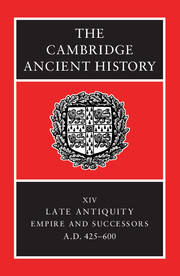Book contents
- Frontmatter
- PART I CHRONOLOGICAL OVERVIEW
- PART II GOVERNMENT AND INSTITUTIONS
- PART III EAST AND WEST: ECONOMY AND SOCIETY
- PART IV THE PROVINCES AND THE NON-ROMAN WORLD
- 18 The north-western provinces
- 19 Italy, A.D. 425–605
- 20 Vandal and Byzantine Africa
- 21a Asia Minor and Cyprus
- 21b Syria, Palestine and Mesopotamia
- 21c Egypt
- 22a The Sasanid monarchy
- 22b Armenia in the fifth and sixth century
- 22c The Arabs
- 23 The Balkans and Greece 420–602
- PART V RELIGION AND CULTURE
- Conclusion
- Chronological Table
- BIBLIOGRAPHY
- Index
- References
22a - The Sasanid monarchy
from PART IV - THE PROVINCES AND THE NON-ROMAN WORLD
Published online by Cambridge University Press: 28 March 2008
- Frontmatter
- PART I CHRONOLOGICAL OVERVIEW
- PART II GOVERNMENT AND INSTITUTIONS
- PART III EAST AND WEST: ECONOMY AND SOCIETY
- PART IV THE PROVINCES AND THE NON-ROMAN WORLD
- 18 The north-western provinces
- 19 Italy, A.D. 425–605
- 20 Vandal and Byzantine Africa
- 21a Asia Minor and Cyprus
- 21b Syria, Palestine and Mesopotamia
- 21c Egypt
- 22a The Sasanid monarchy
- 22b Armenia in the fifth and sixth century
- 22c The Arabs
- 23 The Balkans and Greece 420–602
- PART V RELIGION AND CULTURE
- Conclusion
- Chronological Table
- BIBLIOGRAPHY
- Index
- References
Summary
ROMANS AND SASANIDS
A chapter dealing with Iranian feudalism in a distinguished series dedicated to The Rise and Fall of the Roman World bears the title Iran, Rome’s Greatest Enemy. This title is more than merely a justification for the inclusion of a chapter on Iran in a series whose subject is Roman history. It also reflects a host of fears and prejudices fostered for long centuries in the Roman world, since the trauma of Crassus’ defeat by the Parthians at Carrhae. Not even extended periods of decline and internal disarray within the Parthian monarchy, in the course of which it was repeatedly invaded by the Roman army, could dispel the myth of the uncompromising threat posed by Iran to the Roman order. The replacement of the Parthian Arsacid dynasty by a new vigorous one, based in Fars, namely the Sasanid dynasty, at a time when the Roman empire itself was facing one of its severest crises, only aggravated its inhabitants’ deeply rooted fear of Iran. Ancient writers in the Roman oikoumene passed on this attitude to modern western scholars.
It is the Sasanid bogeyman which has left a deep imprint in modern historiography. The Sasanid state is widely regarded as a much more centralized and effective political entity than its Parthian counterpart, with a far better army. The great pretensions and aspirations of its monarchs are believed to have been fed by the fervour of religious fanaticism, inspired by the Zoroastrian priesthood, which is commonly depicted as a well organized state church.
- Type
- Chapter
- Information
- The Cambridge Ancient History , pp. 638 - 661Publisher: Cambridge University PressPrint publication year: 2001
References
- 26
- Cited by



